1. Introduction
TEAC CD-W540E IDE CDR-W -
Page 1
- Introduction
 as Plextor, introduced directly a 40x CD-RW drive, skipping entirely the 32x
recording platform. The company's previous model, CD-W524E was a very solid
drive that earned our "Editor's Choice Award" and this made many users,
including us, to wait for the new drive with great expectations. We compare
side to side almost all current 40x recording solutions from Plextor, LiteOn,
ASUS and of course TEAC. Which drive performed better at our test bench? Which
drive has the wider media compatibility and gives the lower recording times
among with maximum quality? Let's find out…
as Plextor, introduced directly a 40x CD-RW drive, skipping entirely the 32x
recording platform. The company's previous model, CD-W524E was a very solid
drive that earned our "Editor's Choice Award" and this made many users,
including us, to wait for the new drive with great expectations. We compare
side to side almost all current 40x recording solutions from Plextor, LiteOn,
ASUS and of course TEAC. Which drive performed better at our test bench? Which
drive has the wider media compatibility and gives the lower recording times
among with maximum quality? Let's find out…
- Features
According to TEAC there are several new improvements over previous models:
Fine Focus Control
 "…The
required strength of the laser varies greatly with writing and reading processes.
With the movement of the write head with conventional CD-R (W) drives, faults
often occur when writing and reading. TEAC has made a breakthrough with the
new "Fine Focus Control" technology, in that the laser always remains
constant and never enters a "jitter mode". The laser remains precisely
in the same position on the track, regardless of the speed. This key CD writing
technology from TEAC enables the high recording quality with very high speeds…"
"…The
required strength of the laser varies greatly with writing and reading processes.
With the movement of the write head with conventional CD-R (W) drives, faults
often occur when writing and reading. TEAC has made a breakthrough with the
new "Fine Focus Control" technology, in that the laser always remains
constant and never enters a "jitter mode". The laser remains precisely
in the same position on the track, regardless of the speed. This key CD writing
technology from TEAC enables the high recording quality with very high speeds…"
The top left picture shows the solution from most manufacturers. Below is
what TEAC proposes:

Intelligent Speed Control
A further qualitative improvement is the "Intelligent Speed Control"
technology, which sufficiently tests the status of the CD before the writing
process using various parameters in order to determine the highest writing speed
with the best possible quality. For example, the number of tracks, disk balance,
strength of the laser, type of disk and any possible vibrations with higher
rotation speeds are all tested.
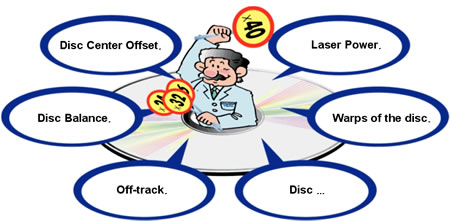
Mount Rainier Industry Standard
The drive is Mt. Rainier format ready, un-like to some other 40x CD-RW drives,
as it currently stands. Plextor, Sanyo and other manufacturers plan to support
it with a firmware upgrade in the near future.
Mount Rainer is a collection of specifications that is designed to enable
problem-free use of CD-RW media. Instead of supplementary programs, the support
is anchored in the hardware and in the operating system. The core of the specification
is the division of the media into two-kilobyte blocks, a management for faults
in the drive and a background formatting of the media. Using traditional CD-RW
media in a Mount Rainer environment is as easy as pre-formatting floppy disks.
Other features:
*New advanced servo circuit to make the accurate track positioning.
* High speed ROPC (Running Optimum Power Control) based on the sampling at approx.
4,800 times per second. It enables the optimal recording not only from the most
inner track to the outer most track, but also for any portion on each track.
* Rugged mechanical chassis using 1.2mm thick of metal-sheet. It minimizes the
vibration, which affects the recording quality.
- Specs
 TEAC
CD-W540E uses an optical pickup from Sanyo Electric Co. LTD, type: SF-W33L with
laser output > 2.0mW (Play) and 56mW (Record) on the objective lens and wavelength
of 780-786nm laser output.
TEAC
CD-W540E uses an optical pickup from Sanyo Electric Co. LTD, type: SF-W33L with
laser output > 2.0mW (Play) and 56mW (Record) on the objective lens and wavelength
of 780-786nm laser output.
The recording speeds are: 4X, 8X, 16X, 20x (CLV) & 20x(16x)-24x, 20x(16x)-32x
and 20x(16x)-40x (Z-CLV). The value in parentheses is applied during writing
in CD-DA, CD-ROM XA Mode 2 Form 1 and CD-ROM XA Mode 2 Form 2. The re-writing
speeds are 4x, 10x & 12x (CLV).
The drive's maximum reading speed is 48x (CAV) for CD-ROM Mode 1, CD-ROM XA
Mode 2 Form 1 and CD-RW formats. For the "CD-DAE, CD-ROM XA Mode 2 Form
2" formats, maximum speed is reduced to 40x (CAV). TEAC again (!) reduces
the seek time standards and this time specifications give an average seek time
down to 72ms (!).
The drive has the industry's biggest MTBF (>100.000, 5years designed life)
and comes with 8MB of buffer among with "Write-Proof" technology (Sanyo's
BURN-Proof).
Even TEAC said that drive supports 8MB buffer, CD-R software reports that
the drive has only 6746KB. TEAC explanation is clear "…6746KB is actual
usable area of the 8MB Buffer and historically, TEAC drive reports usable area.
However, all or most of CD-RW suppliers' way of report is different and we are
the only supplier who reports actual size. Our engineers believe reporting actual
size is better, kind to the user. However, after we received many questions
on this issue, we decided to show 8MB, instead of actual usable area to avoid
confusion. This will be fixed with upcoming v1.0C firmware revision…"
In addition, TEAC says that the buffer is 2M bytes under MRW mode and 4M bytes
during read.
2. Introduction - Page 2
TEAC CD-W540E IDE CDR-W -
Page 2
- TEAC's 40x writing speed
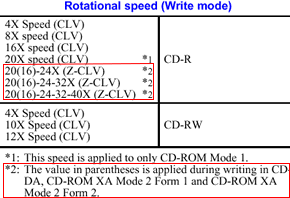 TEAC
CD-W540E reaches maximum 40x writing speed in two ways: 16x-24-32-40x or 20-24-32-40x.
The first strategy is used for CD-ROM Mode 1 discs, while the second in CD-DA,
CD-ROM XA Mode 2 Form 1 and Form 2 discs. Also the 20x (CLV) is only applied
to CD-ROM Mode 1 tasks.
TEAC
CD-W540E reaches maximum 40x writing speed in two ways: 16x-24-32-40x or 20-24-32-40x.
The first strategy is used for CD-ROM Mode 1 discs, while the second in CD-DA,
CD-ROM XA Mode 2 Form 1 and Form 2 discs. Also the 20x (CLV) is only applied
to CD-ROM Mode 1 tasks.
TEAC officially supports only two media manufacturers for the maximum recording
speed - Mitsubishi Chemicals and Hitachi-Maxell 40x certified media. If you
use other media, the drive will write them at 20x(16x) - 32x. Future firmware
updates will add more media in the supported list for the 40x writing speed.

TEAC CD-W540E supports the 40x writing speed and uses the Z-CLV writing technology.
Below is the Nero CD Speed writing graph, which illustrates the use of Zone-CLV
writing technology.
The 20x-40x writing speed range is divided into four zones: The drive starts
writing at 20x from the lead-in till the 4mins, then shifts up to 24x at 8min
until 22mins, shifts to 32x at 26mins, shifts to the 40x at 50mins and stays
there until the end of the burning process. The average recording speed is 31.25X
making it currently the faster recorder available:

With CD-DA, CD-ROM XA Mode 2 Form1 and Form2 tasks, the 16x-40x writing speed
range is divided into four zones. The only change compared to the 16x-40x is
that the drive starts writing at 16x instead of the 20x. The rest of the shift
points are exactly the same. At this mode, the average recording speed is 30.86X
making it almost as fast as the rest 40x recorders.

With some media, we noticed something weird at the end of the recording process.
The drive lowers its recording speed at 76mins. This was noticed with Ricoh's
80min 24x media:

There are cases, in which the drive will start writing at 20x, shift up to
24x/32x but afterwards, reduces speed down to 24x! TEAC drive really can adjust
its recording strategy according to the quality of the inserted media:

- The package
 The
supplied package is the retail Europe version and contains: TEAC CD-W540E, one
Mitsui 80min 40x certified blank, one TEAC 74min 4-10x HS-RW blank, a printed
operation manual in 7 languages, mounting screws and audio/IDE cables. The main
software is Nero 5.5.7.7, and InCD v3.2.3. The drive has a 2-year warranty (only
for Europe) and can be found at the retail price of 169 Euros.
The
supplied package is the retail Europe version and contains: TEAC CD-W540E, one
Mitsui 80min 40x certified blank, one TEAC 74min 4-10x HS-RW blank, a printed
operation manual in 7 languages, mounting screws and audio/IDE cables. The main
software is Nero 5.5.7.7, and InCD v3.2.3. The drive has a 2-year warranty (only
for Europe) and can be found at the retail price of 169 Euros.
For the first time we saw a 40x certified media from Mitsui Chemicals:

The European package doesn't include a 12x certified HS-RW media, TEAC has
included a coupon card for buyers in order to receive a TEAC 8-12x HS-RW media
for free around May:

The front of the drive looks like as all previous TEAC CD-RW drives. You
can see the usual eject button, the headphone input jack/volume selector and
two leds:

The TEAC CD-W540E leds blink as follows:

At the back of the drive you will find the usual connectors (IDE interface,
power), the jumpers for setting the drive to Master/Slave option, the analogue
and the digital audio output connectors and a hole, which is called "Frame
Ground". The frame of the CD-RW drive is electrically connected to 0VDC.


- Installation
 TEAC
CD-W540E was installed as Master in the secondary IDE BUS. The drive worked
in UDMA-2 mode and after boot up, it identified itself as the "TEAC
CD-W540E". Under WinXP, DMA was automatically activated
TEAC
CD-W540E was installed as Master in the secondary IDE BUS. The drive worked
in UDMA-2 mode and after boot up, it identified itself as the "TEAC
CD-W540E". Under WinXP, DMA was automatically activated
The drive is a March 2002 model with firmware revision v1.0B installed. For
the most of our tests we used the Nero v5.5.7.9 among with Ahead InCD v3.24.3
(for packet writing tests) and CloneCD 3.3.4.1/4.0.0.9.

3. Data Tests
TEAC
CD-W540E IDE CDR-W- Page
3
Data Tests
- SCSI Mechanic v3.0x results
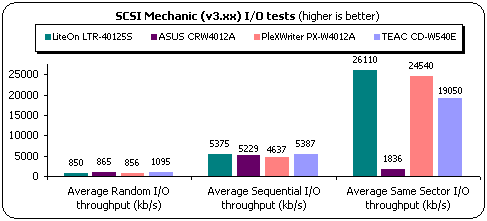
TEAC CD-W540E is the faster drive among the 40x CD-RW drives. The drive's
average Sequential reading speed was 5387Kb/s and gave a very high Random I/O
result of 1095Kb/s, due to its lowest seek times. LiteOn LTR-40125S comes second
in the Sequential test and third in the Random I/O test. PleXWriter PX-W4012A
cannot really compete due to its lower reading speed.
- Pressed CD results: (Click to view
the CD Speed Graph)

In the Nero CD Speed test, TEAC CD-W540E is the fastest drive, with 36.82X
average reading speed. LiteOn LTR-40125S comes second with 36.81X and ASUS CRW4012A
third with 35.59X.
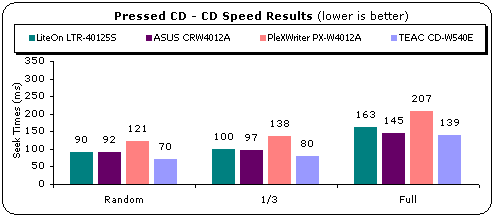
In the same test, TEAC sets a new standard with the lowest seek time ever
measured for an optical drive! TEAC gives 72ms as random seek times and Nero
CD Speed with the PlexTools v1.08 CD gave 70ms. The LiteOn comes second with
90ms and ASUS third with 92ms. PleXWriter PX-W4012A is slower with 121ms. With
CDR media, the seek times of the drive reached the 73ms, very close to the specifications.
- CDR Media: (Click to view
the CD Speed Graphs)

With CDR media, TEAC CD-W540E continues to hold the first place and increased
its performance compared to the pressed disc test. It gave an average reading
speed of 37.57X and LiteOn LTR-40125S comes second with 36.66X. ASUS CRW4012A
comes third with 35.84X and PleXWriter last with 31.59X.
- HS-RW media: (Click to view
the CD Speed Graphs)
For the RW tests we used a Ricoh HS-RW written at 10x. TEAC again leads the
race, since it can read up to 48x (CAV) high-speed RW media:
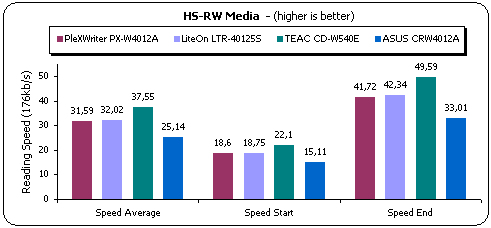
4. CloneCD Reading Tests
TEAC CD-W540E IDE CDR-W
- Page 4
CloneCD Tests
- Procedure
We used CloneCD (v3.3.4.1) and 4 original CDs - No One Lives For Ever (SafeDisc
2), Desperados (LaserLock 2), V-Rally 2 Expert (SecuROM 2) and NBA Jam Extreme
(PSX) - in order to test the reading time of the drives. We also tested the
reading performance with backups of the original CDs, since the reading speed
varies between original and backup media. The following pictures show the drive(s)
reading/writing capabilities as CloneCD reports:

- PSX Pressed Media
ASUS CRW4012A is the faster reader with 48secs. PleXWriter PX-W4012A and
TEAC CD-W540E get the second place with 54secs and LiteOn last with 116secs:
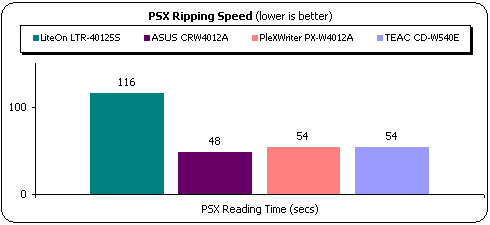
- SafeDisc 2 Results

PleXWriter PX-W4012A is the faster reader for SafeDisc 1/2 protected CDs.
ASUS CRW4012A follows and LiteOn comes third. TEAC CD-W540E is really slow,
since it needs almost 25minutes to read the test disc.
- LaserLock 2 Results

With LaserLock v.2 protected CDs, ASUS CRW4012A performed very well and gets
the first place with the original disc. PleXWriter comes first with the backup
disc. TEAC CD-W540E is really slow with both original/backup discs.
- SecuROM Results

All tested drives can read SubChannel data from Data/Audio tracks. LiteOn
LTR-40125S comes first, ASUS CRW4012A second, PleXWriter PX-W4012A third and
TEAC CD-W540E last.
5. DAE Tests
TEAC CD-W540E IDE CDR-W
- Page 5
DAE Tests
- Test Method
We used CD DAE 99 v0.3 beta and EAC v0.9 beta 2 software in order to check
the DAE performance of the drive with various AudioCDs (both pressed and CDR).
The posted DAE results are the average of both applications. We made a full
CD Rip starting from the first to the last track of the CD. The Average DAE
reported speeds are displayed in the test graphs.
- DAE features
We used EAC v0.9 beta 2 to examine the drive features:
 The
drive does "Caching" data, supports "Accurate Stream" and
"C2" error info.
The
drive does "Caching" data, supports "Accurate Stream" and
"C2" error info.
As TEAC says, the drive supports up to 40x (CAV) DAE ripping speeds. However
with some of the test discs, we saw DAE up to 48x. We haven't got yet an answer
if this was a bug or an improvement of the DAE speeds with specific media:
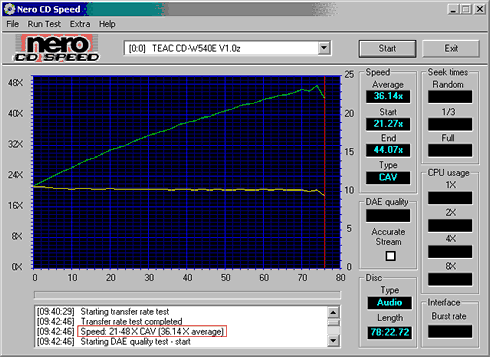
- Pressed AudioCD results
LiteOn LTR-40125S is the faster reader at the 40x recording race with AudioCDs.
The drive supports up to 48x (CAV) reading speed, and its average reading speed
is 34X. ASUS CRW4012A comes second with 33.6X, PleXWriter PX-W4012A third with
30.1X and TEAC CD-W540E last with 28.2X. It seems the drive has been tuned upon
the quality than the ripping speed:

- CDR AudioCD results
All the drives behaved the same in the CDR DAE test, as in the previous
pressed CD test. PleXWriter PX-W4012A dropped its reading speed down to 29.7X
and TEAC CD-W540E increased its average reading speed at 29.1X:

- EAC Secure Extract Ripping mode
For each drive we used the build-in detection function:
|
Tested Drives
|
Average DAE Speed (X)
|
|
Pressed
|
CDR
|
|
LiteOn LTR-40125S
|
4.4
|
5.0
|
|
TEAC CD-W540E
|
8.4
|
8.8
|
|
ASUS CRW4012A
|
11.0
|
11.1
|
|
PleXWriter PX-W4012A
|
7.3
|
7.0
|
- Advanced DAE Quality

All tested drives got a 100 score (best) in the Nero CD Speed Advanced DAE
test. TEAC CD-W540E gave a rather strange result of 34.72X and no errors were
produced. As the following picture shows, the drive can read CD-Text/SubChannel
Data and from Lead-In area:
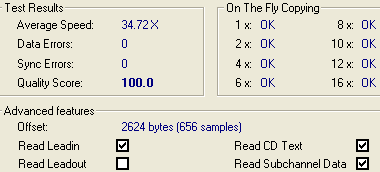
- Bad CDR Media results
Despite the fact that Nero CD Speed Advanced DAE test stretches drive's mechanism
to the max, we decided to do real life tests with a scratched disc. The disc
was dirty, and with some light scratches, enough in order cause problems to
most of the tested drives. We used CD DAE 99 software to rip the whole disc
(756539616 sectors) and the results were very interesting:
|
|
Average Speed (X)
|
Errors
|
Errors Of Total Disc (%)
|
|
LiteOn LTR-40125S
|
15.2
|
472459
|
0.06
|
|
TEAC CD-W540E
|
4.5
|
0
|
0
|
|
ASUS CRW4012A
|
0
|
0
|
0
|
|
PleXWriter PX-W4012A
|
22.6
|
86674027
|
11.46
|
The best reader for this test comes from TEAC. The drive lowered its reading
speed down to 0.5X during the "hard" points and managed to give back
zero (0) errors. The TEAC drive is the best solution for reading those old and
probably scratched media.
- Ripping 90 and 99mins AudioCDs
The drive stops reading around 94mins.
- Reading/Ripping Protected AudioCDs
For the test procedure we used two protected AudioCDs, which we
tested in both recognition and ripping (with CD DAE v0.3b/EAC v0.9 beta2) processes:
* Pressed AudioCD with Sony Key2Audio
* Pressed AudioCD with Cactus Data Shield 200 (Natalie Imbruglia - White Lilies
Island)
|
|
Key2Audio
|
CDS200
|
CDS100
|
|
CDDAE
|
EAC
|
CDDAE
|
EAC
|
CDDAE
|
EAC
|
|
LiteOn LTR-40125S
|
Cannot recognize disc contents
|
Recognizes tracks, cannot rip
|
Recognizes tracks, cannot rips
|
Reads all tracks as Data tracks - ripping
impossible
|
|
TEAC CD-W540E
|
Recognizes tracks, cannot rip
|
Rips entire disc without problems
|
Cannot recognize Audio Tracks
|
Rips entire disc without problems under
special settings
|
|
ASUS CRW4012A
|
Cannot recognize disc contents
|
Recognizes tracks, cannot rip
|
Recognizes tracks, cannot rip
|
|
Plextor PX-W4012A
|
Rips entire disc without problems
|
Rips entire disc without problems
|
Cannot recognize Audio Tracks
|
Rips entire disc without problems under
special settings
|
TEAC CD-W540E can rip protected AudioCDs with EAC software. The Key2Audio disc
is not real problem but for the CDS200 one, you must use the "MANUAL TOC
DETECTION" function of EAC. Also note that the drive did a lot of time
to recognize the Audio Tracks but in the end "ripped" them without
any problem.
6. CDR Tests - Page 1
TEAC CD-W540E IDE CDR-W
- Page 6
CDR Tests
- Page 1
- Procedure
We tested the drive with latest version of Nero/CloneCD. We used various media
for our tests: Mitsubishi Chemicals 74/80min 24x/32x certified, Mitsui 74min
16x/24x/40x certified, Prodisc 80min 32x certified, Taiyo Yuden 74/80min 24x/32x
certified, Ricoh 80min 24x/32x certified and Mitsubishi Chemicals/Ricoh HS-RW
media. We burned CDs at almost all recording speeds from 16x up to 40x using
the SAME amount of data for all drives. The posted recording times are the
best we had from our test results. Using other media can increase the final
burning time.
 The
best results came only with the Mitsubishi Chemical 80min 32x and Hitachi-Maxell
80min 40x certified media. In case you use other media and even select 40x speed,
they will be written either at 32x speed or at the 16x-40x writing strategy.
For the HS-RW tests, the drive supports 12x with the Ricoh media. The bulked
HS-RW media can only be written up to 10x. The TEAC drive lowers its maximum
recording speed, when low quality media is inserted down to 32x or 24x:
The
best results came only with the Mitsubishi Chemical 80min 32x and Hitachi-Maxell
80min 40x certified media. In case you use other media and even select 40x speed,
they will be written either at 32x speed or at the 16x-40x writing strategy.
For the HS-RW tests, the drive supports 12x with the Ricoh media. The bulked
HS-RW media can only be written up to 10x. The TEAC drive lowers its maximum
recording speed, when low quality media is inserted down to 32x or 24x:


- Comparison
Before starting the recording tests, let's see how the drives are compared
in the writing/rotation speeds:
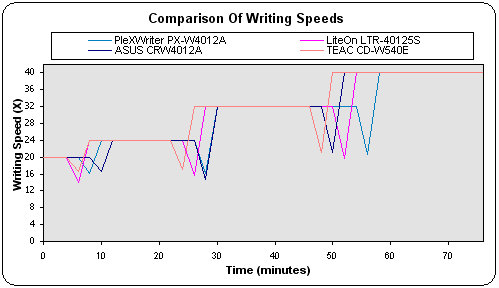
The above chart displays the different approaches towards 40x Zone-CLV recording
speeds between Plextor, ASUS, LiteOn and TEAC. The TEAC drive start writing
at 20x as the rest of the recorders and shifts at 6mins to 24x. The drive lowers
less its recording speed at this point and at the next zones shifts earlier
to the 32x and to 40x speeds. This makes it the faster recorder around. Again
we must note that this performance will be accomplished with specific media.
|
Drive
|
Average Writing Speed (X) with 80min
CDs
|
|
PleXWriter PX-W4012A
|
29.91
|
|
ASUS CRW-4012A
|
30.39
|
|
LIteOn LTR-40125S
|
30.49
|
|
TEAC CD-W540E
|
31.25
|
The TEAC drive has the highest rotation speed that never exceeds the 10.000rpm.
Higher rotation speeds means more noise and higher recording speeds.
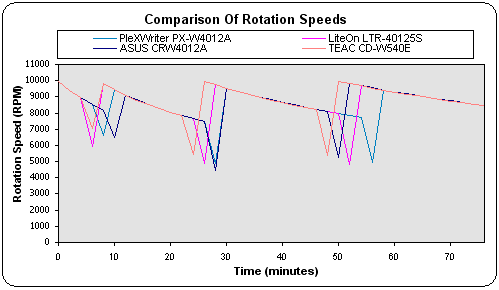
- 74min CD-R Tests
We created a "DataCD" job with data slightly more than 74mins (74:03:65).
We burned the same job with all five tested drives. The faster drive at the
16x writing test comes from LiteOn. The drive finished the task in 304 sec (SmartBurn
disabled). TEAC CD-W540E needs four more seconds to finish (308sec), ASUS CRW4012A
comes third and PleXWriter PX-W4012A last with 319secs:

The faster recorder at the 20x writing speed comes again from LiteOn. The
LTR-40125S needs 250secs and CD-W540E six more second to end the task:

At the 24x writing speed, the TEAC drive comes second with 222secs. LiteOn
LTR-40125S is faster by two seconds:

The time difference has been lowered at the 32x writing speed.
The TEAC drive is one second slower than the LiteOn drive, a result which however
could change with different media:

At the maximum writing speed, TEAC CD-W540E takes the first
place. The drive ends the task at 3:05mins and gets the title of the fastest
recorder around. LiteOn LTR-40125S comes second with 188secs, PleXWriter PX-W4012A
third with 198sec and ASUS CRW4012A last with 201secs. Note that with current
firmware, 40x speed is supported only for two media types so with most media
recording performance would be lower:
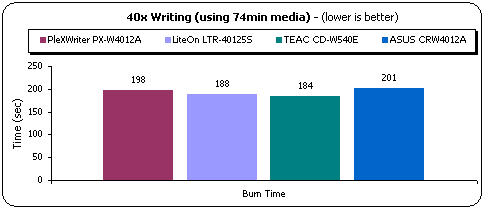
The following picture comes from a Taiyo Yuden 32x certified
media burned at the 40x speed. Even if the 40x speed is selectable, the final
recording time is much higher than we should expect. The media was actually
burned at 32x speed, as the second picture confirms.
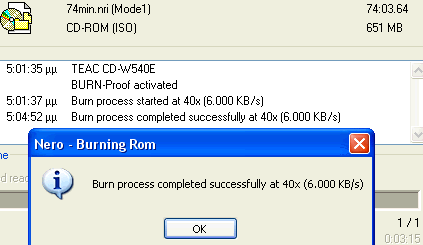
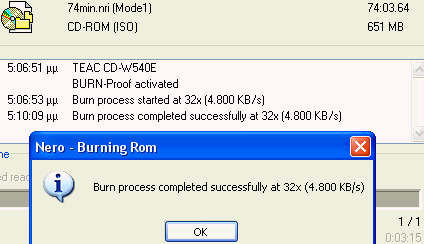
The third picture comes from Mitsubishi Chemical 32x-40x certified media.
With Hitachi-Maxell media, we had one-two seconds higher recording time.

7. CDR Tests - Page 2
TEAC
CD-W540E IDE CD-RW - Page
7
CDR Tests
- Page 2
- 80min CD-R Tests
In our normal burning tests the 80min CD contains slightly more than 80min
data (80:01:47). With 80min CDs, LiteOn LTR-40125S gets the first place. TEAC
CD-W540E needs four more seconds to end the task:

At the 20x, 24x and 32x (Zone-CLV) writing speeds, the faster
recorder again comes from LiteOn. The TEAC drive comes second with a 4-5secs
difference in performance:


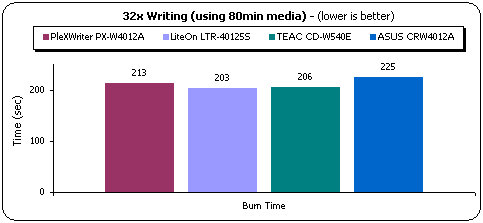
At the maximum writing speed, TEAC CD-W540E comes first. It
ends the task at 3:04 and is currently the faster recorder. LiteOn follows with
195secs and both PleXWriter/ASUS drives are much slower:

- Recording performance comments
Viewer may be troubled from the recording results. Despite the fact that
TEAC CD-W540E has the highest average recording speed of the four tested drives,
the recording times, with an exception in the maximum recording speed (40x),
are higher than LiteOn LTR-40125S. How could this happen?
The answer can be found if you read the LiteOn LTR-40125S review. The posted
recording times are the lower we had with "Smart-Burn" Off. In that
mode, the drive doesn't take the same time, in start; to calibrate the media
as would happen with "Smart-Burn" enabled. Many users will turn-off
"Smart-Burn" enabling the 40x recording speed with lower quality media.
This way, user can have the lowest recording times but with questionable recording
quality.
With the TEAC CD-W540E you can't turn off the quality media detection system.
That means that in any case you will have the maximum available recording speed,
with the highest writing quality.
- Comparison between recording Technologies
Let's now compare the faster recorders for each category. TEAC CD-W540E
is the faster drive at the 40x recording speed, at least for now, and its time
differences from other recorders are:

With 74min CDs:
- 46secs faster than PleXWriter PX-W2410A
- 41secs faster than Yamaha CRW3200E
- 19secs faster than CyberDrive CW-058D
With 80min CDs:
- 56secs faster than PleXWriter PX-W2410A
- 47secs faster than Yamaha CRW3200E
- 25secs faster than CyberDrive CW-058D
Even if the most of users expected very big differences, the test results
reveille the truth. The 40x recorders offer significant performance boost only
compared to the 20x/24x Zone-CLV recorders. We can call "significant"
a gap of 56secs with 80minCD compared to the Plextor 2410A drive. Again remember
that in such high recording speeds, 40x certified media would give you the absolute
performance.
8. CDR Tests - Page 3
TEAC
CD-W540E IDE CD-RW - Page
8
CDR Tests
- Page 3
- AudioCD Authoring
TEAC CD-W540E permits AudioCD authoring up to 40x. We created two CDs at
the 16x (CLV) and 40x (Zone-CLV) and we measured the C1 error rate of the used
Mitsubishi Chemicals 80min 32x certified media:
|
|
C1 Error Rate
|
|
max
|
average
|
|
Writing Speed 16x
|
16
|
1.2
|
|
Writing Speed 40x
|
29
|
1.5
|
Even at the 40x writing speed, the writing quality stays at high levels. The
drive will produce higher C1 error rate at the 40x (Z-CLV) writing speed, as
expected, but the average stays low enough. Of course with different media results
can be reversed. That's why we only advise using quality media for AudioCD recording
in such high recording speeds.
|
|
DAE Ripping Speed
|
|
Writing Speed 16x
|
Writing Speed 40x
|
|
TEAC CD-W540E
|
28.8X
|
28.7X
|
The ripping capabilities of TEAC CD-W540E are also not affected from the
increased writing speed.
- Other features
|
Overburning Writing
|
Up to 99mins
|
|
CD-Text (Read/Write)
|
Yes/Yes
|
|
8cm CDs
|
Yes
|
- CloneCD Writing Tests
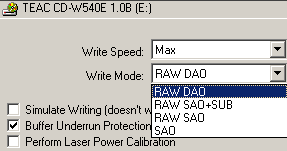 CloneCD
v3.3.4.1 reports that the drive supports the DAO-RAW feature. We performed our
usual tests and we confirmed that both drives support the DAO-RAW writing mode
at the following CD protections: SafeDisc 1, LaserLock 1/2 and SecuROM 2 CD
protections. TEAC CD-W540E supports up to 40x writing speeds under the DAO-RAW
mode.
CloneCD
v3.3.4.1 reports that the drive supports the DAO-RAW feature. We performed our
usual tests and we confirmed that both drives support the DAO-RAW writing mode
at the following CD protections: SafeDisc 1, LaserLock 1/2 and SecuROM 2 CD
protections. TEAC CD-W540E supports up to 40x writing speeds under the DAO-RAW
mode.
- SD2 Support
For the SD2 test we used the "Emperor: Battle for Dune", "Max
Payne", "Serious Sam - The Second Encounter" and "Medal
of Honour Allied Assault" game titles. We used the drive both as reader/writer
at the maximum reading/recording speed. The produced backups were tested with
the following readers: TEAC CD-540E, Creative CD5233 and Plextor PX-40TS CD-ROM
drives.
- Results
|
|
SafeDisc2 Build
|
Worked (Yes/No)
|
|
Emperor: Battle of Dune
|
v2.30.031
|
Yes
|
|
Max Payne
|
v2.30.033
|
No
|
|
Serious Sam - The Second Encounter
|
v2.51.021
|
No
|
|
Medal of Honor Allied Assault
|
No
|
|
Serious Sam - The Second Encounter
|
v2.51.021 ( Amplify Weak Sectors with
CloneCD v4.x)
|
Yes with some drives
No at the same TEAC CD-W540E drive
|
|
Medal of Honor Allied Assault
|
The results are clear. The drive can backup v2.30.031 but not the higher builds.
User may create "partial working" backups with the "Amplify Weak
Sectors" setting of latest CloneCD v4.x series. The produce backup worked
at Creative 52x, so far our reference drive for backups, but there was not success
in the TEAC CD-W540E drive...
9. Writing Quality Tests
TEAC
CD-W540E IDE CD-RW - Page
9
Writing Quality Tests
We used many media and burned them at various recording speeds with TEAC
CD-W540E. We used Nero 5.5.7.9 as the CDR software. The produced CDs were measured
by DigitalDrives
and the results are illustrated in the following tables:
- 20x writing speed
|
Brand
|
C1
|
Average Burning Time (mins)
|
|
Max
|
Average
|
|
Taiyo Yuden 74min (24x)
|
8
|
0.5
|
4:16
|
|
|
|
|
|
|
Rrodisc 80min (32x)
|
30
|
3.0
|
4:31
|
The C1 error rate is very low with TaiyoYuden media at the 20x writing speed.
- 24x writing speed
|
Brand
|
C1
|
Average Burning Time (mins)
|
|
Max
|
Average
|
|
Taiyo Yuden 74min (24x)
|
11
|
1.2
|
3:42
|
|
Maxell 74min (12x)
|
23
|
3.5
|
3:47
|
|
TDK D-View (12x)
|
30
|
2.5
|
3:42
|
|
|
|
|
|
|
Taiyo Yuden 80min (32x)
|
17
|
2.5
|
3:57
|
As we can see, the writing time differs from media to media. The drive worked
very well even with 12x media from Maxell and TDK.
- 32x writing speed
|
Brand
|
C1
|
C2
|
Average Burning Time (mins)
|
|
Max
|
Average
|
Max
|
Average
|
|
Taiyo Yuden 74min (16x)
|
14
|
1.6
|
|
3:42
|
|
Taiyo Yuden 74min (24x)
|
17
|
2.4
|
3:15
|
|
Taiyo Yuden 74min (32x)
|
24
|
2.5
|
3:15
|
|
Mitsubishi Chemicals 74min (24x)
|
22
|
3.1
|
3:14
|
|
Verbatim 74min (16x)
|
19
|
2.2
|
3:40
|
|
Creation 74min (16x)
|
22
|
1.8
|
3:15
|
|
Mitsui 74min (16x)
|
96
|
1.7
|
171
|
0.1
|
4:20
|
|
Mitsui 74min (24x)
|
550
|
10.7
|
|
3:14
|
|
|
|
|
|
|
Creation 80min (16x)
|
36
|
9.7
|
3:44
|
|
Verbatim 80min (16x)
|
28
|
3.7
|
3:26
|
|
Taiyo Yuden 80min (32x)
|
30
|
3.1
|
3:26
|
The highest C1 error rate comes from Mitsui media. The problem is that Mitsui
CDs, have less recording capacity than other media. We burn data with 74:03:65mins
long, so with Mitsui media, each drive must overburn. As it seems, the TEAC
drive doesn't handle them too well, and as a result, in the last minutes the
C1 error rate increases and we also saw a C2 error rate. With the rest media,
writing quality is very good.
At the 32x writing speed, we can see several interesting results. The recording
times for 74min CDs are divided in 3 categories. The first category is at 3:15mins,
the second category at 3:40mins and the last at 4:20mins. So what happened?
The drive at the first category shifted up writing speed from 20x-32x! At the
second category, the drive followed the 20x-24x-32x-24x writing strategy and
at the third, wrote the media at 20x (CLV).
The following three pictures show the performance with different media types.
The first picture shows the drive's best performance at the 32x writing speed.

The second picture shows that a specific type of media needed 3:42mins (32x).
This happened when we used Taiyo Yuden 74min 16x certified media.

The last picture comes from Mitsui Chemicals SG Ultra (16x certified). The
drive automatically lowered the recording speed down to 20x.

- 40x writing speed
|
Brand
|
C1
|
Average Burning Time (mins)
|
|
Max
|
Average
|
|
Taiyo Yuden 74min (32x)
|
21
|
2.3
|
3:15
|
|
Hitachi-Maxell 74min (40x)
|
21
|
2.3
|
3:06
|
|
Mitsubishi Chemicals 74min (32x)
|
17
|
1.4
|
3:04
|
|
Sanyo Digital 74min (16x)
|
22
|
0.9
|
3:14
|
|
|
|
|
|
|
Ricoh 80min (32x)
|
34
|
4.9
|
3:26
|
|
Ricoh 80min (40x)
|
45
|
3.3
|
3:27
|
|
Mitsubishi Chemicals 80min (24x)
|
57
|
6.3
|
3:25
|
|
Mitsubishi Chemicals 80min (32x)
|
27
|
1.5
|
3:13
|
|
Hitachi-Maxell 80min (40x)
|
23
|
2.3
|
3:13
|
|
Prodisc 80min (32x)
|
35
|
2.2
|
3:15
|
|
Mitsui 80min (40x)
|
42
|
3.7
|
3:16
|
|
Taiyo Yuden 80min (32x)
|
29
|
3.4
|
3:27
|
At the 40x writing speed, again the recording results are separated in two
categories. At the 74min CDs, we have the best results with Mitsubishi Chemicals
(3:04) and the worst with Taiyo Yuden 32x media.
At the 80min CDs, the best results come again from Mitsubishi Chemicals/Hitachi
Maxell and Mitsui 40x certified media, and the worst from the rest of the media.
The best results came at 20x-40x. The C1 error rate is low and especially with
the Mitsubishi Chemicals media.
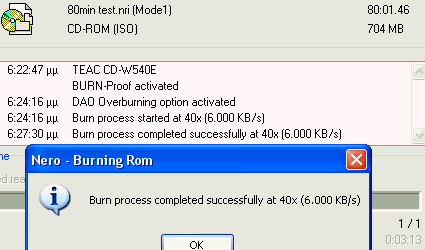

10. RW-Packet Writing Tests
TEAC CD-W540E IDE CDR-W
- Page 10
RW Writing Tests
We used Nero 5.5.7.9 for writing CDs at the maximum RW speed for all the tested
drives. TEAC CD-W524E needs 6:50mins to end the task, taking the third place,
behind Plextor and LiteOn drives. The erase times are higher than LiteOn but
the same as the Plextor drive:

- Packet Writing Tests
We used Ahead InCD v3.24.3 for all Packet Writing tests with a Ricoh HS-RW
media. The included TEAC 4-10x doesn't support 12x re-writing. The formatting
of the media takes around 11 minutes. The formatted disc had 534mbs of free
space. We copied a 403 MB file (403.147 kbs) from a Hard Disk (on the same PC
as the writers) to the formatted RW media using Windows Explorer (we dragged
and dropped) and we completed the test twice to eliminate any possible time
measurement faults and user errors:

TEAC CD-W540E has the third best packet writing performance. The differences
however with the two faster drives are down to 0.01X-0.04X, which have no practical
sense. At the reading part the drive has the lowest reading performance of 8.45X.
TEAC explained the reduced packet-writing reading speed "…If the
CD-RW disc used is other than Ricoh HS CD-RW, TEAC CDW540E will write at 10X
at 32 blocks of user date and 7 link blocks per Packet (= 39 blocks/packet).
The actual transfer rate will be 32/39*10x which is approx. 8.2x. The read speed
after write will be maintained as write speed. With other vendors' drive, when
the drive reads the data after write, it read at the same speed during write
however, after reading certain blocks or certain time period, the drive will
spin-up to 32x or 48x…"
11. Mt. Rainier Tests
TEAC CD-W540E IDE CDR-W
- Page 11
Mt. Rainier Format Tests
TEAC CD-W540E is the first 40x recorder drive that supports the famous Mt.
Rainier format. Already, Yamaha CRW3200E and Mitsumi CR-480ATE support this
feature. At the properties tab of InCD v3.24.3 we can see the Mt. Rainier option.
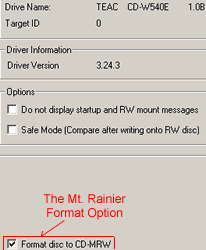
Before we start the format process, let's see the disc status. Nero reports
that the Ricoh HS-RW media is empty and no MRW format is present:

The formatting process, is now shorter:

The format is finished, within less than 2 minutes, and our disc is ready for
use:

After we completed our tests, we checked again the formatting process. Nero
now reports that formatting is still in progress. We will have to wait until
17mins to end before being able to use the media in other system.

For testing, we decided to eject the media. Remember the formatting process
is not complete. InCD prompts that needs to add information about the track/session
in order to be readable in other systems. The process will take up to 1minute:


After the disc is ejected, InCD displays a confirmation window:

Let's now check the formatting process. Nero reports that background formatting
is being suspended. The problem now is how will it be resumed? We are not so
sure...

If you leave the disc in the drive for about 20minutes the background formatting
process will finish. There is no indication to user when this ended so you will
have to wait. Nero reports now that disc formatting has ended:

We had installed a Plextor PX-40TS in the test PC. We tried to read the written
data of the CD-MRW disc, but we only got a readme.txt file with the following
content:
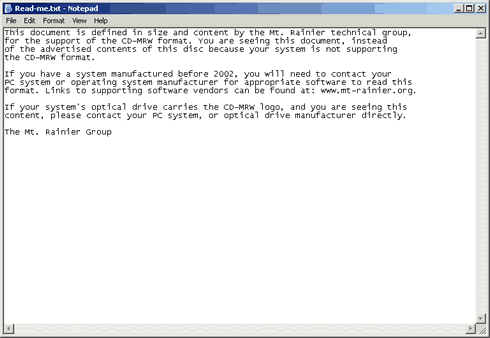
Hmm.. So what's going on? Only CD-MRW enabled recorders can see the contents?
For now yes, until either Ahead or Microsoft releases the proper driver. We
also noticed that if you "early" (before background formatting finishes)
eject- insert and re-eject the disc, InCD will ask again for 1 minute in order
to add information to the disc. We are not so sure if this is normal or it's
a bug of InCD.
- Recording Tests
For testing the Mt. Rainier performance of the TEAC/Mitsumi/Yamaha drive(s),
we performed two tests. Mitsumi CR-480ATE was tested with v1.0E and Yamaha CRW3200E
with v1.0d firmware revisions.
First Test
After the format process, we immediately start the recording process (drag
& drop). When the drive finishes, we start the reading process back to the
HD. At this mode, the drive writes, reads the quality of the written data and
background formats the disc at the same time. The recording performance of each
drive is displayed in the below table:
|
Drive
|
Average Writing Speed (X)
|
Average Reading Speed (X)
|
|
TEAC CD-W540E
(v1.0b firmware)
|
3.45
|
3.77
|
|
Mitsumi CR-480ATE
(v1.0E firmware)
|
2.38
|
5.40
|
|
Yamaha CRW3200E
(v1.0d firmware)
|
2.55*
|
-
|
The faster drive at this mode comes from TEAC. The drive seems
robust enough to finish this test first and without any glitches. Mitsumi CR-480ATE
comes third with 2.38X. The Yamaha CRW3200E did came second during the write
process with 2.55X. Afterwards when trying to access the written data, the PC
locked and the drive didn't respond. After rebooting the disc was empty. Maybe
it's a bug of either InCD or from the CRW3200E drive itself. The Mitsumi CR-480ATE
is the faster drive at the reading process with 5.40X.

Second Test
At the second test, we left the drive alone to complete the background formatting
and afterwards, we repeated the above tests. The recording/reading performance
in this case is higher for all the drives, since now only record & read
are performed. The disc has been scanned for bad sectors during the format process:
|
Drive
|
Average Writing Speed (X)
|
Average Reading Speed (X)
|
|
TEAC CD-W540E
(v1.0b firmware)
|
2.65
|
7.03
|
|
Mitsumi CR-480ATE
(v1.0E firmware)
|
3.34
|
8.76
|
|
Yamaha CRW3200E
(v1.0d firmware)
|
3.89
|
18.32
|
The faster drive at both reading/writing comes from Yamaha. The
CRW3200E with the v1.0d firmware has 3.89X writing and 18.32X reading speeds.
The drive didn't showed the weird behaviour we had at the first test. The Mitsumi
CR-480ATE comes second with 3.34X writing and 8.76X reading speed. TEAC CD-W540E
didn't performed so well with only 2.65X writing and increased 7.03X reading
speeds.
- Mt. Rainier performance conclusion
As we can see writing at a CD-MRW formatted HS-RW takes double
the time to end the task than with the normal packet writing format. That is
happening since the drive not only writes, but also monitors the quality of
the written data to avoid problems. Future firmware updates can improve the
drive's reading/writing performance. Also higher re-writing speeds will boost
the Mt. Rainier performance.
As a side note, we must say that only Mitsumi CR-480ATE has taken
Philips "EasyWrite" logo that ensures the proper implementation of
Mt. Rainier format...
12. Conclusion
TEAC CD-W540E IDE CDR-W
- Page 12
Conclusion
|
Positive
(+)
|
Negative
(-)
|
|
- Currently the FASTEST 40x Zone-CLV
recorder
- 8MB Buffer
- Supports "Burn-Proof" anti-coaster technology
- Huge MTBF > 100.000 hour
- Supports Mt. Rainier format out the box
- Will write many media at 40x
- Low C1C2 at 40x even with non certified media
- Excellent seek times (70ms!)
- Can "handle" protected Audio CDs
- Perfect DAE ripping quality
- Supports overburning (up to 99min)
- Supports DAO-RAW
- Supports reading/writing of SubChannel data
- Supports CD-Text (reading/writing)
- 2years of warranty (applies only for Europe)
- Good price ( $150< retail box)
|
- Lower DAE performance than competition
- Low Packet-Writing reading performance
- Very bad CloneCD reading performance
- Cannot produce accurate SD2 backups
- Drive is noisy as the competition…
|
Many users expected the TEAC 40x drive to decide when -and if- they should
upgrade their system. TEAC gave the CD-W540E a specific design "Quality"
versus "Speed". The drive's reading mechanism is improved and the
lowest seek times of the industry are here! The drive will also decrease its
reading speed to read any inserted media. It will also write many media, even
16x certified, at the maximum (40x recording) speed with a good recording quality.
Mt. Rainier format is present, making it the only 40x recorder that supports
it out of the box. Finally, it's the fastest reader as far as it concerns Data
CDs, at this category and supports overburning (up to 99min CDs).
Its' weakest point is the reading/writing performance of protected CDs. Of
course the reading performance can be surpassed with the help of a good reader,
but the recording part cannot be. The drive cannot backup SafeDisc 2 v2.5x CDs,
which the competition from LiteOn/ASUS and partially Plextor does. The DAE is
lower than the competition, but as we said earlier, speed is sacrificed in the
name of quality.
The drive's price makes it directly comparable to the PleXWriter PX-W4012A.
The TEAC drive is faster at reading/writing tests, has Mt. Rainier (Plextor
will support it also with future firmware) and has "wider" media compatibility
for the 40x recording speed. The PleXWriter has some unique features (VariRec,
Black Tray) and support for SD2 v2.50.x CDs. Lastly; both drives have two years
of warranty.
Comparing the drive with the LiteOn LTR-40125S, we can say that TEAC is slightly
faster at both reading and writing tests, has lower DAE speeds and better recording
quality. LiteOn has SD2 v2.51 support and almost $40-50 less price. As usual,
you must balance your needs and decide which drive fits yours needs best.
TEAC CD-W540E gets our "Editors Choice Award" for its performance/value
for money. Let’s hope that the upcoming CD-W548E will get no negative comments
;-)

